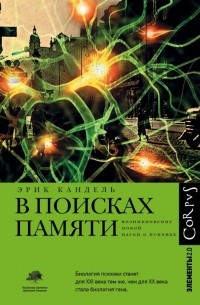
Эрик Кандель – лучшие книги
- 7 произведений
- 13 изданий на 3 языках
По популярности
-
В поисках памяти Эрик Кандель
ISBN: 978-5-17-137356-6 Год издания: 2021 Издательство: АСТ, Corpus Язык: Русский Автор разъясняет революционные достижения современной биологии и проливает свет на то, как бихевиоризм, когнитивная психология и молекулярная биология породили новую науку. Книга начинается с воспоминаний о детстве в оккупированной нацистами Вене и описывает научную карьеру Канделя: от его раннего увлечения историей и психоанализом до новаторских работ в области изучения клеточных и молекулярных механизмов памяти, за которые он удостоился Нобелевской премии.
-
Расстроенная психика. Что рассказывает о нас необычный мозг Эрик Кандель
ISBN: 978-5-17-119013-2 Год издания: 2020 Издательство: АСТ, Corpus Язык: Русский Все решения и поступки зарождаются в нашей психике благодаря работе нейронных сетей. Сбои в ней заставляют нас страдать, но порой дарят способность принимать нестандартные решения и создавать шедевры. В этой книге нобелевский лауреат Эрик Кандель рассматривает психические расстройства через призму “новой биологии психики”, плода слияния нейробиологии и когнитивной психологии. Достижения нейровизуализации, моделирования на животных и генетики помогают автору познавать тайны мозга и намечать подходы к лечению психических и даже социальных болезней. Он разбирает массу интересных вопросов.
Велика ли роль генов в развитии психических расстройств? А роль бессознательного в творчестве и принятии решений? Что общего у болезней, привычно разделяемых на неврологические и психические, и каковы их биологические механизмы? А что общего у искусства людей с шизофренией и “обычных” сюрреалистов? Можно ли возродить психоанализ? И что дают нам все эти знания? -
Век самопознания. Поиски бессознательного в искусстве и науке с начала XX века до наших дней Эрик Кандель
ISBN: 978-5-17-085501-8 Год издания: 2016 Издательство: АСТ, Corpus Язык: Русский Лауреат Нобелевской премии в области физиологии и медицины (2000 г.) и знаток модернистского искусства Эрик Кандель приводит нас в блистательную Вену рубежа XIX-XX веков — город Зигмунда Фрейда, Артура Шницлера и Густава Климта. Здесь — в художественных мастерских, врачебных кабинетах и светских салонах — около ста лет назад началась революция, изменившая наши представления о психике и ее отношениях с искусством.
-
Reductionism in Art and Brain Science (Bridging the Two Cultures) Эрик Кандель
ISBN: 978-0231179621 Год издания: 2016 Издательство: Columbia University Press Are art and science separated by an unbridgeable divide? Can they find common ground? In this new book, neuroscientist Eric R. Kandel, whose remarkable scientific career and deep interest in art give him a unique perspective, demonstrates how science can inform the way we experience a work of art and seek to understand its meaning. Kandel illustrates how reductionism―the distillation of larger scientific or aesthetic concepts into smaller, more tractable components―has been used by scientists and artists alike to pursue their respective truths. He draws on his Nobel Prize-winning work revealing the neurobiological underpinnings of learning and memory in sea slugs to shed light on the complex workings of the mental processes of higher animals.
In Reductionism in Art and Brain Science, Kandel shows how this radically reductionist approach, applied to the most complex puzzle of our time―the brain―has been employed by modern artists who distill their subjective world into color, form, and light. Kandel demonstrates through bottom-up sensory and top-down cognitive functions how science can explore the complexities of human perception and help us to perceive, appreciate, and understand great works of art. At the heart of the book is an elegant elucidation of the contribution of reductionism to the evolution of modern art and its role in a monumental shift in artistic perspective. Reductionism steered the transition from figurative art to the first explorations of abstract art reflected in the works of Turner, Monet, Kandinsky, Schoenberg, and Mondrian. Kandel explains how, in the postwar era, Pollock, de Kooning, Rothko, Louis, Turrell, and Flavin used a reductionist approach to arrive at their abstract expressionism and how Katz, Warhol, Close, and Sandback built upon the advances of the New York School to reimagine figurative and minimal art. Featuring captivating drawings of the brain alongside full-color reproductions of modern art masterpieces, this book draws out the common concerns of science and art and how they illuminate each other. -
Psychiatry, Psychoanalysis, and the New Biology of Mind Эрик КандельBrought together for the first time in a single volume, these eight important and fascinating essays by Nobel Prize-winning psychiatrist Eric Kandel provide a breakthrough perspective on how biology has influenced modern psychiatric thought. Complete with commentaries by experts in the field, Psychiatry, Psychoanalysis, and the New Biology of Mind reflects the author's evolving view of how biology has revolutionized psychiatry and psychology and how potentially could alter modern psychoanalytic thought.The author's unique perspective on both psychoanalysis and biological research has led to breakthroughs in our thinking about neurobiology, psychiatry, and psychoanalysis – all driven by the central idea that a fuller understanding of the biological processes of learning and memory can illuminate our understanding of behavior and its disorders. These wonderful essays cover the mechanisms of psychotherapy and medications, showing that both work at the same level of neural circuits and synapses, and the implications of neurobiological research for psychotherapy; the ability to detect functional changes in the brain after psychotherapy, which enables us, for the first time, to objectively evaluate the effects of psychotherapy on individual patients; the need for animal models of mental disorders; for example, learned fear, to show how molecules and cellular mechanisms for learning and memory can be combined in various ways to produce a range of adaptive and maladaptive behaviors; the unification of behavioral psychology, cognitive psychology, neuroscience, and molecular biology into the new science of the mind, charted in two seminal reports on neurobiology and molecular biology given in 1983 and 2000; the critical role of synapses and synaptic strength in both short- and long-term learning; the biological and social implications of the mapping of the human genome for medicine in general and for psychiatry and mental health in particular; The author concludes by calling for a revolution in psychiatry, one that can use the power of biology and cognitive psychology to treat the many mentally ill persons who do not benefit from drug therapy.Fascinating reading for psychiatrists, psychoanalysts, social workers, residents in psychiatry, and trainees in psychoanalysis, Psychiatry, Psychoanalysis, and the New Biology of Mind records with elegant precision the monumental changes taking place in psychiatric thinking. It is an invaluable reference work and a treasured resource for thinking about the future.






